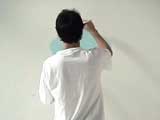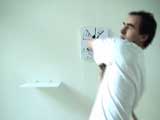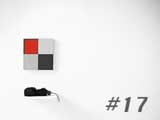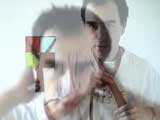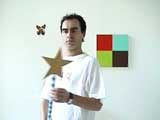Autoportrait
/ self-portrait
Autoportrait
poétique et social de Xavier Cahen.
L'autoportrait, sous forme de séquence vidéo, est le moyen
de parcourir l’univers de l’artiste.
Poetical and social self-portrait of Xavier Cahen.
Self-portrait is video sequence and it is the way to show the artist’s
world.
>
Untitle / Sans titre / #01 / 3,1 Mo / .mov
>
Untitle / Sans titre / #02 / 3,9 Mo / .mov
>
Untitle / Sans titre / #03 / 2,8 Mo / .mov
>
Untitle / Sans titre / #04 / 2,9 Mo / .mov
>
Untitle / Sans titre / #05 / 2,8 Mo / .mov
>
Untitle / Sans titre / #06 / 2,9 Mo / .mov
>
Untitle / Sans titre / #07 / 2,5 Mo / .mov
>
Untitle / Sans titre / #08 / 2,9 Mo / .mov
>
Untitle / Sans titre / #09 / 2,7 Mo / .mov
>
Untitle / Sans titre / #10 / 2,4 Mo / .mov
>
Untitle / Sans titre / #11 / 6,9 Mo / .mov
>
Untitle / Sans titre / #12 / 6,6 Mo / .mov
>
Untitle / Sans titre / #13 / 3,6 Mo / .mov
>
Untitle / Sans titre / #14 / 5,2 Mo / .mov
>
Untitle / Sans titre / #15 / 5,8 Mo / .mov
>
Untitle / Sans titre / #16 / 5,4 Mo / .mov
>
Untitle / Sans titre / #17 / 4,3 Mo / .mov
>
Untitle / Sans titre / #18 / 4,9 Mo / .mov
>
Untitle / Sans titre / #19 / 4,0 Mo / .mov
> Untitle / Sans titre / #20 / 5,1 Mo / .mov
>
Untitle / Sans titre / #21 / 8,9 Mo / .mov
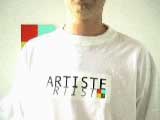
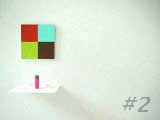
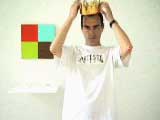
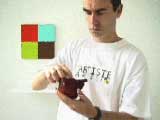
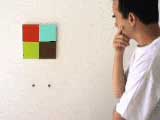
« O que je donnerais bien de l'argent pour être
ou plus bête ou plus spirituel, athée ou mystique,
mais enfin quelque chose de complet, d'entier,
une identité, quelque chose en un mot ».
Gustave Flaubert
| Définition du portrait Vocabulaire d’esthétique, auteur Etienne SOURIAU |
Dans
les arts plastiques
Dans les arts plastiques, on n’emploie pas le terme de portrait
pour la sculpture, et pourtant la chose y existe, mais on dit tête,
buste ou statue ; portrait se dit pour une œuvre en deux dimensions,
peinture ou dessin. Le portrait est donc déjà une interprétation
et transcription, donc choix, pour rendre l’apparence extérieure
d’une personne, quel que soit le degré de réalisme.
Bien qu’uniquement visuel, le portrait peut rendre très sensible
la personnalité intérieure du modèle, par de nombreux
indices tels que la pose, l’expression de la physionomie, etc.
Un
intérêt pour l’individuel
Le genre du portrait, dans quelque art que ce soit, témoigne
d’un intérêt pour l’individuel ; ce n’est
pas seulement l’être humain en général, ou tel
type de toute une espèce, que rend le portraitiste ; c’est
telle personne en tant qu’elle est elle-même (et ceci, même
si au travers de l’individu transparaît une idée de
portée générale : le portrait ne s’y réduit
pas). Ce caractère existe aussi bien dans le portrait œuvre
autonome, que dans le portrait morceau d’une œuvre plus large
; si un romancier fait au passage le portrait d’un de ses personnages,
si dans une scène à plusieurs personnages la représentation
de chacun par le peintre est un portrait, c’est bien l’individu
en tant que tel qui y apparaît. Dans la numismatique, il est arrivé
souvent que l’on prête une sorte de physionomie symbolique
à valeur générique, et non pas ses traits propres,
à tel personnage figurant sur une monnaie ; ce n’est donc
pas alors un portrait.
Mais les idées de l'époque sur un idéal esthétique
humain transparaissent souvent dans le portrait, surtout quand le modèle
veut y paraître beau et que le peintre ou l'écrivain le flatte.
On voit aussi certains types génériques d'époque
chez les portraitistes mondains.
| L'autoportrait |
Enfin il faut faire une place à part à l'autoportrait
où l'artiste se représente lui-même. Il présente
l'avantage pratique qu'on a toujours sous la main son modèle et
qu'on ne dépend pas ainsi des autres ; il a l'inconvénient
pratique qu'à se voir dans un miroir on a de soi une image inversée
; il a la difficulté psychique qu'on y est trop directement intéressé
pour se voir facilement de manière impartiale. L'autoportrait,
surtout quand il est fréquent chez un artiste, est un témoignage
du genre d'intérêt qu'on se porte à soi-même.
Mais qu'on fasse son propre portrait ou celui d'un autre, le portrait
marque toujours qu'on attribue une importance à l'haeccéité
du moi, à l'identité personnelle."
Définition du portrait in Etienne SOURIAU, Vocabulaire d’esthétique,
Paris : P.U.F., 1990, pp.1161-1162.Self-portrait



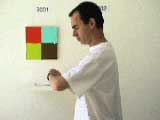

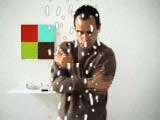
< retour
| Définition du portrait Vocabulary of esthetics, autor Etienne SOURIAU |
In the visual arts
In the visual arts, one does not employ the term of portrait for the sculpture,
and yet the thing exists there, but one says head , bust or statue ; portrait
is said for a work in two dimensions, painting or drawing. The portrait
is thus already an interpretation and transcription, therefore choice,
to make appearance external of a person, whatever the degree of realism.
Although only visual, the portrait can make very sensitive the interior
personality of the model, by many indices such as the installation, the
expression of the aspect, etc.
An
interest for the individual one
The kind of the portrait, in some art that it is, testifies to an interest
for the individual one; it is not only the human being in general, or
such type of a whole species, which the portraitist returns; it is such
person as it is itself (and this, even if through the individual shows
through an idea of general interest: the portrait is not reduced to it).
This character exists as well in the portrait works autonomous, as in
the portrait piece of a broader work; if a novelist makes in the passing
the portrait of one of his characters, if in a scene with several characters
the representation of each one by the painter is a portrait, it is well
the individual as such who appears there. In the numismatics, it often
happened that one lends a kind of aspect symbolic system to generic value,
and not its own features, with such character being reproduced on a currency;
it is thus not then a portrait.
But the ideas of the time on a human aesthetic ideal often show through
in the portrait, especially when the model wants to appear to with it
beautiful and that the painter or the writer flatters it. One sees also
certain generic types of time in the portraitists society men.
| The self-portrait |
Finally it is necessary to make a special place with the self-portrait
where the artist represents itself. It has the practical advantage which
one always has under the hand his model and which one does not depend
thus on the others; it has the practical disadvantage that to see itself
in a mirror one has to self a reversed image; it has the psychic difficulty
that one is too directly interested there to see oneself easily in an
impartial way. The self-portrait, especially when it is frequent in an
artist, is a testimony of the kind of interest which one goes to oneself.
But that one makes his own portrait or that of another, the portrait always
marks that one attaches an importance to the haecceity of ego, with the
personal identity. "
Definition of the portrait in Etienne SOURIAU, Vocabulary of esthetics,
Paris: P.U.F., 1990, pp.1161-1162.
